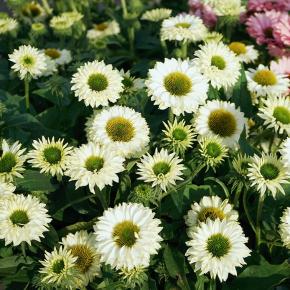Echinacea SunSeekers Blush®, also known as coneflower, is a compact and hardy perennial that brightens gardens with its large blush-pink blooms and orange cone-shaped centers. Prolific and pollinator-friendly, it flowers from summer to fall. Perfect for borders, beds, or containers, this low-maintenance plant thrives in sunny locations, making it a standout in any garden.
|
Packaging
To find out more about our packaging, please visit our young plants' page available from the website header.

|
Available quantity | Dispo à partir de | Sold by | Desired quantity | |
|---|---|---|---|---|---|
|
Packaging
GT9
To find out more about our packaging, please visit our young plants' page available from the website header.

|
Available quantity 256 | Dispo à partir de Immédiat | Sold by min 10 |
|
|
Characteristics of Echinacea SunSeekers Blush®
Echinacea SunSeekers Blush® is a compact variety of coneflower native to the North American prairies, perfectly suited for modern gardens. It produces an abundant and prolonged display of blooms from June to September. Its large flowers, with soft pink petals and a prominent orange cone, attract bees and butterflies. Hardy to -25 °C, this perennial thrives in varied climates and performs best in full sun. Its semi-evergreen, dark green foliage adds year-round interest to the garden.
How to use Echinacea SunSeekers Blush®?
Echinacea SunSeekers Blush® is highly versatile in garden design. It pairs beautifully with ornamental grasses and other perennials in flower beds for a natural yet structured look. In borders, it adds elegant pops of color, while its moderate height makes it ideal for containers on sunny terraces or balconies. With its extended bloom period and ability to attract pollinators, this plant is an excellent choice for gardens promoting biodiversity.
Tips for successfully growing Echinacea SunSeekers Blush®
To plant Echinacea SunSeekers Blush®, choose a well-drained, nutrient-rich soil that remains slightly moist, although it can tolerate drier conditions. Position it in full sun and space plants 40 to 50 cm apart. Water moderately, especially during dry periods, but avoid overwatering to prevent root rot. A light application of organic fertilizer in spring will enhance flowering. Deadheading spent blooms encourages continuous flowering, while clearing old foliage in late winter prepares the plant for spring regrowth.








